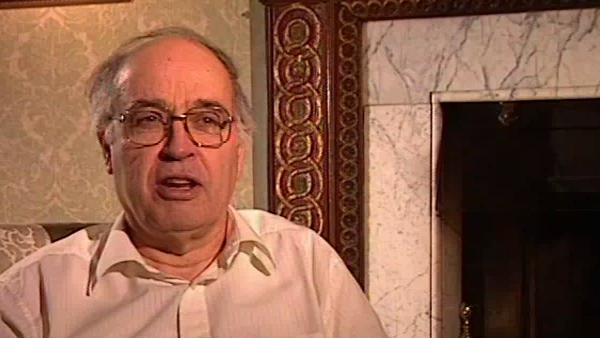NEXT STORY

Individual contributions
RELATED STORIES

NEXT STORY

Individual contributions
RELATED STORIES


|
Views | Duration | |
|---|---|---|---|
| 61. Lacunas and hyperbolic equations | 551 | 04:01 | |
| 62. Further research on lacunas | 443 | 02:36 | |
| 63. Instanton | 1 | 628 | 03:25 |
| 64. Evolving story of instantons | 528 | 02:38 | |
| 65. Almost beaten by Manin | 929 | 01:31 | |
| 66. Euclidian version of twistor theory | 636 | 02:08 | |
| 67. Collaborating with physicists | 1239 | 02:08 | |
| 68. The lack of a background in physics | 1 | 1229 | 02:02 |
| 69. Three manifold invariants | 790 | 02:55 | |
| 70. Individual contributions | 675 | 01:02 |


All the work on anomalies was the perturbation expansion of field theories. The... the theory about invariance of three manifolds. Of course that was a big... big breakthrough and I remember very clearly being at the... at the meeting in Swansea when... when we went out to a restaurant and – Annie's Restaurant it was called – and... and we had dinner. And during the course of the dinner, Graeme Segel and Ed Witten and I… actually the whole thing, you know, emerged and we spent several hours while everybody else had gone away. And Ed Witten was writing on all the napkins and by the end of the evening the whole theory was sort of buttoned up. And the next morning he gave a new talk, cancelled his other talk, and the whole thing was finished. It was, sort of, dramatic.
So it was... it was quite a surprise, but we'd been trying to understand the role of some of those invariants for a while, dimly seeing bits and pieces of how it emerged, so it wasn't... it wasn’t, sort of, a totally new… we knew there was all this quantum field theory, we knew there were these things people were trying to do. It was a quite a, sort of, spectacular when it sort of locked into play like that, so you know, very satisfying. But these things are never as clean cut as they seem, you know, you're gradually learning bits and pieces and trying to pick up the language, and… but obviously that stuff about knot invariants was a very clean example of it all.
But I mean I'd been previously… let's see, I'm trying to remember the order now. There was... there was that work on the Jones polynomial, but before that there'd been the work on the Donaldson theory and I'd already… when I'd talked to the conference about Hermann Weyl, sort of, symposium they held in America… that was before the... the work on three manifolds. And at that stage I was trying to interest the physicists in the three manifold… in the Jones invariants, and trying to speculate they had something to do with gauge theories. And at that time the… and the Donaldson work also, and what Witten… as a result of my, sort of, constantly pestering him when I was at the institute for one term, towards the end of the term he suddenly discovered how to express the Donaldson theory in terms of quantum field theory and how these twisted Yang–Mills theories gave the right answer. And he was very, very excited by that and he thought it was, you know, it was really… it was a big breakthrough.
So there was that one on the one hand, and then the search for the Jones invariants on the other hand, so I was... I was sort of, you know, I was pushing for it behind the scenes. I wasn't actually, sort of, doing the work, Witten was doing the work, but I was actually prodding him saying, ‘There ought to be something like this around’. And so I was very, you know, gratified when it all worked out. So I could see there were these nice tantalising things in mathematics which ought to have [an] explanation in terms of quantum field theory. And you know, it was just the right moment when it actually all... all fell into place.
Eminent British mathematician Sir Michael Atiyah (1929-2019) broke new ground in geometry and topology with his proof of the Atiyah-Singer Index Theorem in the 1960s. This proof led to new branches of mathematics being developed, including those needed to understand emerging theories like supergravity and string theory.
Title: Three manifold invariants
Listeners: Nigel Hitchin
Professor Nigel Hitchin, FRS, is the Rouse Ball Professor of Mathematics and Fellow of Gonville and Caius College, Cambridge, since 1994, and was appointed to the Savilian Professorship of Geometry in October 1997. He was made a Fellow of the Royal Society in 1991 and from 1994 until 1996 was President of the London Mathematical Society.
His research interests are in differential and algebraic geometry and its relationship with the equations of mathematical physics. He is particularly known for his work on instantons, magnetic monopoles, and integrable systems. In addition to numerous articles in academic journals, he has published "Monopoles, Minimal Surfaces and Algebraic Curves" (Presses de l'Universite de Montreal, 1987) and "The Geometry and Dynamics of Magnetic Monopoles" (Princeton University Press, 1988, with Michael Atiyah).
Tags: Swansea, Annie's Restaurant, America, Graeme Segel, Ed Witten, Hermann Weyl
Duration: 2 minutes, 56 seconds
Date story recorded: March 1997
Date story went live: 24 January 2008